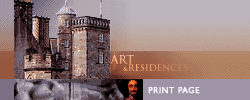The Seton Necklace and earrings (part of a
parure)
late 16th cent. with 17th and 19th
cent. additions
Chain: enamelled gold, pearls, rubies, emeralds;
earrings: enamelled gold, pearls, rubies
Chain: L 9.5 cm; earrings: H 3.4 cm.
Mary Seton; by descent from George, 7th Lord
Seton, to his son Robert, 1st Earl of Winton, to Archibald William, 13th
Earl of Eglinton (1812-61); by whom bequeathed to
his daughters, Egidia, Sybil and Hilda; by whom sold
Christieís 22 February 1894 (lot 69); acquired by
Algernon Borthwick, 1st Baron Glenesk (1830-1908);
by descent to his daughter, Lilias Countess Bathurst
(d.1965); by whom presented to Queen Mary,
the Silver Jubilee, May 1935
The necklace and earrings are part of a parure
together with a brooch.
The necklace consists of a principal gold element
with opaque white, pale-blue, light-green and
translucent blue and green enamel scrollwork set
with pearls, emeralds and rubies. It is flanked by
two enamelled cross-shaped links set with pearls and
emeralds. The chain is composed of six S-shaped
snakes in translucent dark-green enamel coiled
around two pearls and flanked by opaque white enamel
c-scrolls set with rubies; these alternate with 4
S-shaped scroll-like ornaments in opaque white and
translucent blue enamel set with rubies.
The earrings were made to match the snake links
of the chain and adapted by surmounting the earring
hook with pearls and emeralds.
The dating of the pieces is complex and so is the
history of the various parts.
The necklace is a composite piece. The oldest
links are the four on either side of the clasp (four
snake links and four smaller links); they are
reminiscent of other late sixteenth century chain
links of c.1600. The central part of the principal
element and the star link to the left are probably
somewhat later, c.1630. The scrolls surrounding the
central part and the link to the right of it were
probably added at the same time as they both lack
enamel on the reverse. The remaining two
snake-links, the other star link and the border of
the principal element are of a later date.
The earrings were created in the nineteenth
century.
A 1909 inventory in the Royal Collection, to
which the parure has been added at a later date,
states that the parure was given by Mary, Queen of
Scots to her attendant Mary Seton. Mary Seton was a
devoted attendant and friend of Mary, Queen of
Scots, who shared many years of her exile. She was
an excellent hairdresser whose services the Queen
greatly admired
The chain was originally longer; it was a
cotiere - a long chain worn by women caught up
in the breast. Mary Setonís descendant, Alexander
Seton, 6th Earl of Eglinton (d.1661),
removed four snake links and four S-ornaments from
the chain on his succession to the earldom in 1612.
The remaining sixteen snake links and sixteen white
Sís set with rubies were passed to the Hon.
Elizabeth Seton when she married William Hay of
Drummelzier in 1694. The 1909 inventory states that
this part of the chain was recorded in a Hay
inventory in 1727.
The remainder of the jewels passed eventually to
Alexander Setonís descendant, Archibald William,
13th Earl of Eglinton (1812-1861). In the nineteenth
century, the eight links from the original chain
removed by the 6th Earl - four snakes and four
S-ornaments - were incorporated into the present
Neo-Renaissance necklace. This may have been for the
celebrated Eglinton Tournament, held by the 13th
Earl at Eglinton Castle in 1839
The parure remained in the possession of the
Eglinton family until it was sold, together with the
Eglinton family jewels, by the three daughters of
the 13th Earl, Egidia, Sybil and Hilda, in 1894 at
Christieís on 22 February 1894 (lot 69). It was
acquired by Algernon Borthwick, 1st Baron Glenesk
(1830-1908) whose daughter, Lilias Countess Bathurst
(d.1965), presented the parure to Queen
Mary on the occasion of King George Vís Silver
Jubilee in May 1935. |


